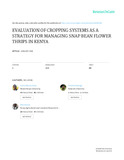Evaluation of cropping systems as a strategy for managing snap bean flower thrips in Kenya

View/
Date
2009Author
Nderitu, J
Mwangi, F
Nyamasyo, G
Kasina, M
Language
enMetadata
Show full item recordAbstract
Four cropping systems were compared in terms of their effectiveness to suppress flower thrips,
Frankliniella occidentalis Pergande and Megalurothrips sjostedti Trybom infestation on Snap beans
(Phaseolus vulgaris L). Maize (Zea mays L) was used either as a margin crop or an intercrop. In
addition, a set of monocrop snap beans were treated with insecticide, Thiacloprid, and another set left
untreated. The treatments were laid out in a Completely Randomised Design with four replicates at
Mwea-Tebere, Central Kenya in two relay cropping periods, first planting in January 2006 followed by
second planting in February 2006. Thrips were sampled from flowers and pods collected from ten
randomly selected plants per plot. The results indicates that there was significant difference (P<0.5)
among the four treatments. The lowest number of adult thrips and their larvae was recorded in plots
treated with Z. mays as inter crop, while the highest was from untreated Snap beans. Thiacloprid treated
plots had the lowest number of M. sjostedti, but F. occidentalis were slightly affected by this pesticide
in both plantings. In general, the population of F. occidentalis was higher than that of M. sjostedti in
both plantings. Snap beans under the intercrop showed the highest percentage of marketable pods
whereas the untreated crop had the highest number of damaged pods which were unmarketable. Thrips
natural enemies were high in the crop surrounded by the margin crop as well as the untreated crop but
least in Thiacloprid treated plots.
